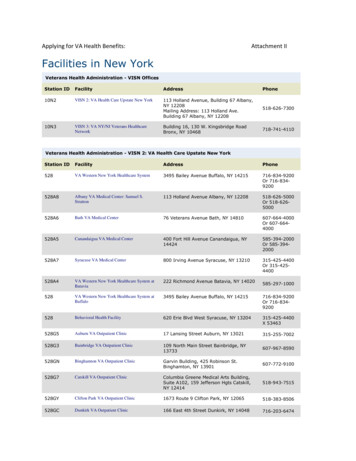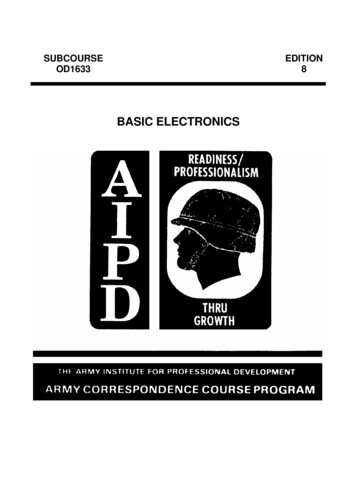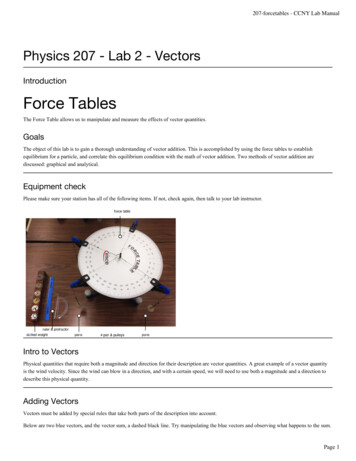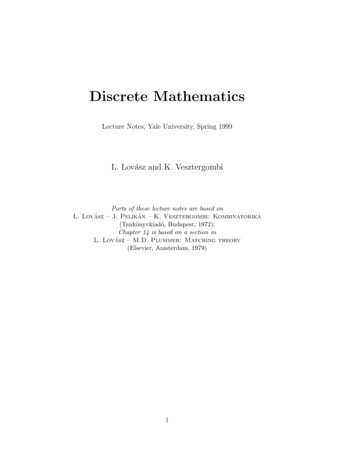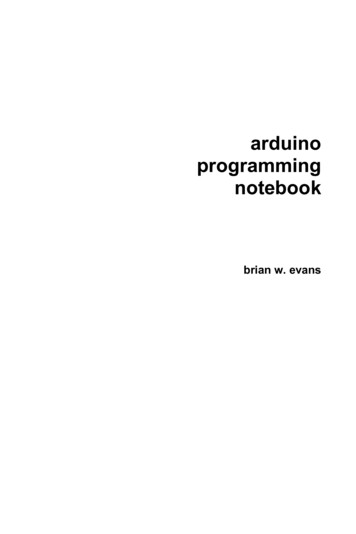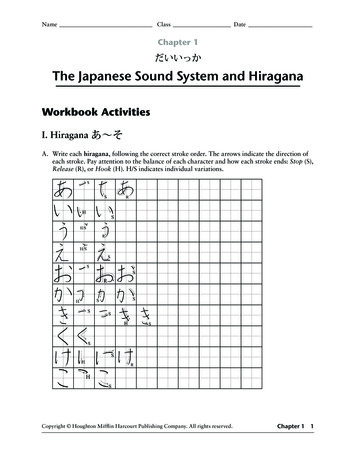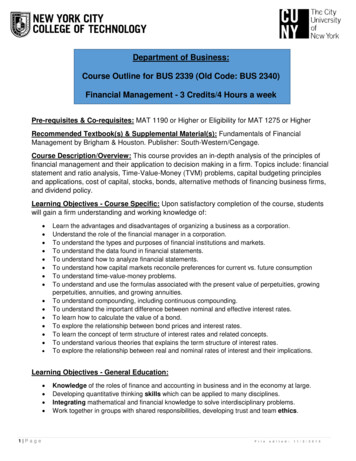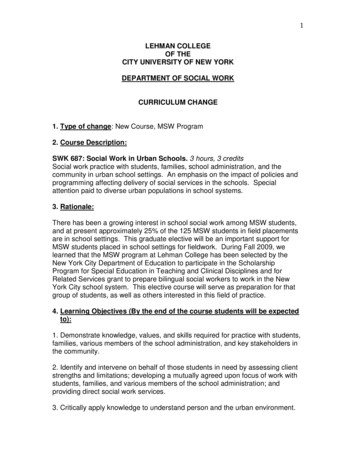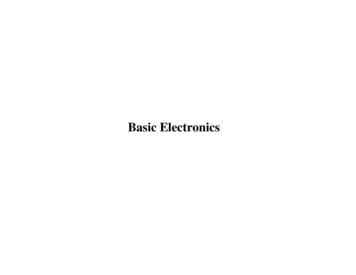
Transcription
Basic Electronics
Semiconductor —I Materials that permit flow of electrons are calledconductors (e.g., gold, silver, copper, etc.). Materials that block flow of electrons are calledinsulators (e.g., rubber, glass, Teflon, mica, etc.). Materials whose conductivity falls between thoseof conductors and insulators are calledsemiconductors. Semiconductors are “part-time” conductorswhose conductivity can be controlled.germaniumSemiconductorssilicon
Semiconductor —II Silicon is the most common material used to build semiconductor devices. Si is the main ingredient of sand and it is estimated that a cubic mile of seawatercontains 15,000 tons of Si. Si is spun and grown into a crystalline structure and cut into wafers to makeelectronic devices.
Semiconductor —III Atoms in a pure silicon wafer contains four electrons in outer orbit (called valenceelectrons).– Germanium is another semiconductor material with four valence electrons. In the crystalline lattice structure of Si, the valence electrons of every Si atom arelocked up in covalent bonds with the valence electrons of four neighboring Si atoms.– In pure form, Si wafer does not contain any free charge carriers.– An applied voltage across pure Si wafer does not yield electron flow through the wafer.– A pure Si wafer is said to act as an insulator. In order to make useful semiconductor devices, materials such as phosphorus (P) andboron (B) are added to Si to change Si’s conductivity.4 valence electrons
N-Type Silicon Pentavalent impurities such as phosphorus, arsenic, antimony, and bismuth have 5valence electrons. When phosphorus impurity is added to Si, every phosphorus atom’s four valenceelectrons are locked up in covalent bond with valence electrons of four neighboringSi atoms. However, the 5th valence electron of phosphorus atom does not find abinding electron and thus remains free to float. When a voltage is applied across thesilicon-phosphorus mixture, free electrons migrate toward the positive voltage end. When phosphorus is added to Si to yield the above effect, we say that Si is dopedwith phosphorus. The resulting mixture is called N-type silicon (N: negative chargecarrier silicon). The pentavalent impurities are referred to as donor impurities.5 valence electrons
P-Type Silicon —I Trivalent impurities e.g., boron, aluminum, indium, and gallium have 3 valenceelectrons.When boron is added to Si, every boron atom’s three valence electrons are locked upin covalent bond with valence electrons of three neighboring Si atoms. However, avacant spot “hole” is created within the covalent bond between one boron atom anda neighboring Si atom. The holes are considered to be positive charge carriers.When a voltage is applied across the silicon-boron mixture, a hole moves toward thenegative voltage end while a neighboring electron fills in its place.When boron is added to Si to yield the above effect, we say that Si is doped withboron. The resulting mixture is called P-type silicon (P: positive charge carriersilicon).The trivalent impurities are referred to as acceptor impurities.3 valence electrons
P-Type Silicon —II The hole of boron atom points towards the negative terminal. The electron of neighboring silicon atom points towardpositive terminal. The electron from neighboring silicon atom falls into theboron atom filling the hole in boron atom and creating a “new”hole in the silicon atom. It appears as though a hole moves toward the negativeterminal!
Diode A diode is a 2 lead semiconductor that acts as a one way gate to electron flow.– Diode allows current to pass in only one direction. A pn-junction diode is formed by joining together n-type and p-type silicon. In practice, as the n-type Si crystal is being grown, the process is abruptly altered togrow p-type Si crystal. Finally, a glass or plastic coating is placed around the joinedcrystal. The p-side is called anode and the n-side is called cathode. When the anode and cathode of a pn-junction diode are connected to external voltagesuch that the potential at anode is higher than the potential at cathode, the diode is saidto be forward biased.–In a forward-biased diode current is allowed to flow through the device. When potential at anode is smaller than the potential at cathode, the diode is said tobe reverse biased. In a reverse-biased diode current is blocked. - -
Water Analogy of Diodes When water pressure on left overcomes the restoring force of spring, the gate isopened and water is allowed to flow . When water pressure is from right to left, the gate is pressed against the solid stopand no water is allowed to flow. Spring restoring force is analogous to 0.6V needed to forward bias a Si diode.
Diode: How it Works —I Whenadiodeisconnected to a battery asshown, electrons fromthe n-side and holes fromthe p-side are forcedtoward the center by theelectrical field suppliedby the battery. Theelectronsandholescombine causing thecurrent to pass throughthe diode. When a diodeis arranged in this way, itis said to be forwardbiased.Repels electronsRepels holesForward-biased (“open door”)
Diode: How it Works—II A diode’s one-way gate feature does not work all the time.Typically for silicon diodes, an applied voltage of 0.6V or greater is needed,otherwise, the diode will not conduct.This feature is useful in forming a voltage-sensitive switch.I-V characteristics for silicon and germanium diodes is shown below.
Diode: How it doesn’t work When a diode isconnected to a battery asshown, holes in the nside are forced to theleft while electrons inthe p-side are forced tothe right. This results inan empty zone aroundthe pn- junction that isfree of charge carriescreating a depletionregion. This depletionregion acts as aninsulatorpreventingcurrent from flowingthroughthediode.When a diode isarranged in this way, itis said to be reversebiased.Attracts holesAttracts electronsReverse-biased (“closed door”)
Diode Applications —Half Wave Rectifier Diode converts ac input voltage to a pulsed dc output voltage. Whenever the ac input becomes negative at diode’s anode, the diode blocks currentflow.– o/p voltage become zero. Diode introduces a 0.6V drop so o/p peak is 0.6V smaller than the i/p peak. The o/p frequency is same as the i/p frequency.Vin
Diode Applications —Full Wave Rectifier A full-wave rectifier does not block negative swings in the i/p voltage, rather ittransforms them into positive swings at the o/p.To gain an understanding of device operation, follow current flow through pairs ofdiodes in the bridge circuit.It is easily seen that one pair (D3-Rout-D2) allows current flow during the ve halfcycle of Vin while the other pair (D4-Rout-D1) allows current flow during the -ve halfcycle of Vin.– o/p voltage peak is 1.2V below the i/p voltage peak.– The o/p frequency is twice the i/p frequency.D1D2D3D4
Diode Applications —AC2DC Power Supply An AC2DC power supplyis built using a transformerand a full-wave rectifier. Transformer is used tostep down the voltage i/p. Rectifier converts AC topulsed DC. A filter capacitor is usedto smooth out the pulses. Capacitor must be largeenough to store sufficientcharge so as to provide asteady current supply to theload:RLoad C 1/ ff is rectified signal’sfrequency (120Hz).
Transistor A three lead semiconductor device that acts as:– an electrically controlled switch, or– a current amplifier.Transistor is analogous to a faucet.– Turning faucet’s control knob alters the flow rate of water coming out from the faucet.– A small voltage/current applied at transistor’s control lead controls a larger current flowthrough its other two leads.Water outWater in
Transistor Types: BJT, JFET, and MOSFET Bipolar Junction Transistor (BJT)– NPN and PNP Junction Field Effect Transistor (JFET)– N-channel and P-channel Metal Oxide Semiconductor FET (MOSFET)– Depletion type (n- and p-channel) and enhancement type (n- and p-channel)BJTJFETMOSFET
BJT Types NPN and PNP.– NPN: a small input current and a positive voltage applied @ its base (with VB VE)allows a large current to flow from collector to emitter.– PNP: a small output current and a negative voltage @ its base (with VB VE) allows amuch larger current to flow from emitter to collector.
NPN BJT: How it works — I When no voltage is applied attransistor’s base, electrons in theemitter are prevented from passingto the collector side because of thepn junction.If a negative voltage is applied tothe base, things get even worse asthe pn junction between the baseand emitter becomes reversebiased resulting in the formation ofa depletion region that preventscurrent flow.
NPN BJT: How it works — II If a positive voltage ( 0.6V) isapplied to the base of an npntransistor, the pn junction betweenthe base and emitter becomesforward-biased. During forwardbias, escaping electrons are drawnto the positive base.Some electrons exit through thebase, but because the p-type baseis so thin, the onslaught ofelectrons that leave the emitter getclose enough to the collector sidethat they begin jumping into thecollector. Increasing the basevoltage increases the emitter-tocollector electron flow.Recall, positive current flow is inthe direction opposite to theelectron flow current flows fromcollector to emitter.
BJT Water AnalogyCollectorBaseEmitterNPN (VB VE)PNP (VB VE)
NPN Transistor in a Complete Circuit —I Normally OFF. No current passes from collector to emitter when base is not activated.NPN: VB VE OFF
NPN Transistor in a Complete Circuit —II When VB VE we have an operating circuit. Current passes from collector to emitter when base is activated.NPN: VB VE ON
Transistor Experiment — LED On/Off Turning the switch on/off turns the LED on/off.
JFET Junction field effect transistors likesemiconductor devices.JFETs are used as:BJTs are three lead– electrically controlled switches,– current amplifiers, and– voltage-controlled resistors. Unlike BJTs, JFETs do not require a bias current and are controlledby using only a voltage.JFETs are normally on when VG - VS 0.When VG - VS 0, then JFETs become resistive to current flowthrough the drain-source pair “JFETs are depletion devices.”
JFET Types Two types of JFETs:– n-channel and p-channel. In n-channel JFET, a –ve voltage applied @ its gate (with VG VS) reduces currentflow from drain to source. It operates with VD VS.In p-channel JFET, a ve voltage applied @ its gate (with VG VS) reduces currentflow from source to drain. It operates with VS VD.JFETs have very high input impedance and draw little or no input current– if there is any circuit/component connected to the gate of a JFET, no current is drawnaway from or sunk into this circuit.
MOSFET Metal oxide semiconductor FET.Similar to JFET.A metal oxide insulator is placed @ the gate to obtain a high input impedance @ thegate– gate input impedance approx. 1014Ω. Use of insulator as described above yields a low gate-to-channel capacitance.– If too much static electricity builds up on the gate, then the MOSFET may be damaged.
MOSFET Types Enhancement type:– Normally off, thus no current flows through drain-source channel when VG VS.– When a voltage applied @ the gate causes VG VS the drain-source channel reducesresistance to current flow. Depletion type:– Normally on, thus maximum current flows through drain-source channel when VG VS.– When a voltage applied @ the gate causes VG VS the drain-source channel increasesresistance to current flow.Current flow increases with:VG VSVG VSCurrent flow decreases with:VG VSVG VS
Optoelectronics In optoelectronics we deal with 2 types of electronic devices.Light emitting electronic devices: ones that generate electromagnetic energy underthe action of electrical field. Example: light emitting diodes (visible and infraredlight).Light detecting devices: ones that transform electromagnetic energy input intoelectrical current/voltage. Examples: photoresistors, photodiodes, phototransistors,etc.Light emitting diodesInfrared detector
Light-Emitting Diodes (LEDs)
LED 101— I 2 lead semiconductor device.Light emitting PN-junction diode.– Visible or infrared light. Has polarity.Recall diodes act as a one way gate to current flow.– A forward-biased PN-junction diode allows current flow from anode to cathode. An LED conducts and emits light when its anode is made more positive (approx.1.4V) than its cathode.– With reverse polarity, LED stops conducting and emitting light.
LED 101— II Similar to diodes, LEDs are current-dependent devices.– LED brightness is controlled by controlling current through LED. Too little current through LED LED remains OFF. Small current through LED dimly lit LED. Large current through LED brightly lit LED. Too much current through LED LED is destroyed. A resistor placed in series with LED accomplishes current control -AnodeCathodeLED symbol
LED 101—III VsRIVR Let Vs be the supply voltage.Let Vf be the required forward bias voltage for theLED.Let I be the desired current flow through LED.Then, the current limiting resistance R is sized asfollow:VR Vs V fVR Vs V fR IIVf If R is chosen smaller than the above value, alarger current will flow through the LED.– LEDs can handle only limited current (varies from20mA to 100mA).– If current through LED is larger than the maximumallowed value, than the LED will be damaged.
Visible-Light LED Inexpensive and durable.Typical usage: as indicator lights.Common colors: green ( 565nm), yellow ( 585nm), orange ( 615nm), and red( 650nm).Maximum forward voltage: 1.8V.Typical operating currents: 1 to 3mA.Typical brightness levels: 1.0 to 3.0mcd/1mA to 3.0mcd /2mA.High-brightness LEDs exist.– Used in high-brightness flashers (e.g., bicycle flashers).
Blinking LED Contain a miniature integrated circuit that causes LED to flash from 1 to 6 times/second. Typical usage: indicator
Basic Electronics. Semiconductor —I Materials that permit flow of electrons are called conductors (e.g., gold, silver, copper, etc.). Materials that block flow of electrons are called insulators (e.g., rubber, glass, Teflon, mica, etc.). Materials whose conductivity falls between those of conductors and insulators are called semiconductors. Semiconductors are “part-time .
